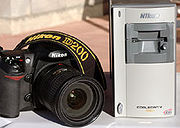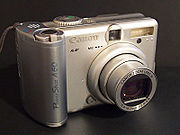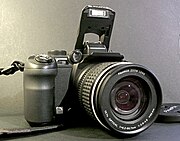Digital camera
A digital camera is an electronic device used to capture and store photographs digitally, instead of using photographic film like conventional cameras, or recording images in an analog format to magnetic tape like many video cameras.
Modern compact digital cameras are typically multifunctional, with some devices capable of recording sound and/or video as well as photographs. In the Western market, digital cameras now outsell their 35 mm film counterparts.[1]
Live-preview digital cameras
The term digital still camera (DSC) most commonly refers to the class of live-preview digital cameras, cameras that use an electronic screen as the principal means of framing and previewing before taking the photograph. All use either a charge-coupled device (CCD) or a CMOS image sensor to sense the light intensities across the focal plane.
Many modern live-preview cameras have a movie mode, and a growing number of camcorders can take still photographs. However, even a low-end live-preview camera can take better still pictures than a mid-range video camera, and mid-range live-preview cameras have much lower video quality than low-end video cameras; that is, products are not generally optimized for both still and video photography, due to their different requirements.
Among live-preview cameras, most have a rear liquid crystal display for both preview and reviewing photographs. Transfers to a computer are commonly carried out using the USB mass storage device class (so that the camera appears as a drive) or using the Picture Transfer Protocol (PTP) and its derivatives; in addition, Firewire is sometimes supported.
The live-preview cameras are typically divided into compact (and subcompact) and bridge cameras.
Compact digital cameras
Also called digicams, this encompasses most digital cameras. They are characterized by great ease in operation and easy focusing; this design allows for limited motion picture capability. They tend to have significantly smaller zooms than bridge and DSLR cameras. They have an extended depth of field. This allows objects at a larger range of depths to be in focus, which accounts for much of their ease of use. They excel in landscape photography and casual use. They typically save pictures in only the JPEG file format. All but the cheapest models have a built-in flash, although its guide number tends to be very low, perhaps just 6 or 8.
Bridge cameras
Bridge or SLR-like cameras form a general group of higher-end live-preview cameras that physically resemble DSLRs and share with these some advanced features, but share with compacts the live-preview design and small sensor sizes.
Bridge cameras tend to have superzoom lenses, which compromises – in varying degrees, depending on the quality of the zoom lens – a "do it all" ability with barrel distortion and pincushioning. These cameras are sometimes marketed as and confused with digital SLR cameras since the bodies resemble each other. The distinguishing characteristics are that bridge cameras lack the mirror and reflex system of DSLRs, have so far been always produced with only one single sealed (non-interchangeable) lens (but accessory wide angle or telephoto converters can be attached to the front of the sealed lens), can usually take movies, record audio and the scene composition is done with either the liquid crystal display or the electronic viewfinder (EVF). The overall performance tends to be slower than a true digital SLR, but they are capable of very good image quality while being more compact and lighter than DSLRs. The high-end models of this type have comparable resolutions to low and mid-range DSLRs. Many of the these cameras can save in JPEG or RAW format. The majority have a built-in flash, often a unit which flips up over the lens. The guide number tends to be between 11 and 15.
Digital single lens reflex cameras
Digital single-lens reflex cameras (DSLRs) are digital cameras based on film single-lens reflex cameras (SLRs), both types are characterized by the existence of a mirror and reflex system. See the main article on DSLRs for a detailed treatment of this category.
Digital rangefinders
A rangefinder is a focusing mechanism once widely used on film cameras, but much less common in digital cameras. The term rangefinder alone is often used to mean a rangefinder camera, that is, a camera equipped with a rangefinder.
For information on digital rangefinders specifically, check the digital rangefinder section in the main article linked above.
Professional modular digital camera systems
This category includes very high end professional equipment that can be assembled from modular components (winders, grips, lenses, etc.) to suit particular purposes. Common makes include Hasselblad and Mamiya. They were developed for medium or large format film sizes, as these captured greater detail and could be enlarged more than 35mm.
Typically these cameras are used in studios for commercial production; being bulky and awkward to carry they are rarely used in action or nature photography. They can often be converted into either film or digital use by changing out the back part of the unit, hence the use of terms such as a "digital back" or "film back." These cameras are very expensive (up to $40,000) and are typically not seen in the hands of consumers.
Conversion of film cameras to digital
When digital cameras became common, a question many photographers asked was if their film cameras could be converted to digital. The answer was yes and no. For the majority of 35 mm film cameras the answer is no, the reworking and cost would be too great, especially as lenses have been evolving as well as cameras. For the most part a conversion to digital, to give enough space for the electronics and allow a liquid crystal display to preview, would require removing the back of the camera and replacing it with a custom built digital unit.
Many early professional SLR cameras, such as the NC2000 and the Kodak DCS series, were developed from 35 mm film cameras. The technology of the time, however, meant that rather than being a digital "back" the body was mounted on a large and blocky digital unit, often bigger than the camera portion itself. These were factory built cameras, however, not aftermarket conversions.
A notable exception was a device called the EFS-1, which was developed by Silicon Film from ca. 1998–2001. It was intended to insert into a film camera in the place of film, giving the camera a 1.3 MP resolution and a capacity of 24 shots. Units were demonstrated, and in 2002 the company was developing the EFS-10, a 10 MP device that was more a true digital back.
A few 35 mm cameras have had digital backs made by their manufacturer, Leica being a notable example. Medium format and large format cameras (those using film stock greater than 35 mm), have users who are capable of and willing to pay the price a low unit production digital back requires, typically over $10,000. These cameras also tend to be highly modular, with handgrips, film backs, winders, and lenses available separately to fit various needs.
The very large sensor these backs use leads to enormous image sizes. The largest in early 2006 is the Phase One's P45 39 MP imageback, creating a single TIFF image of size up to 224.6 MB. Medium format digitals are geared more towards studio and portrait photography than their smaller DSLR counterparts, the ISO speed in particular tends to have a maximum of 400, versus 6400 for some DSLR cameras.






0 Comments:
Post a Comment
Subscribe to Post Comments [Atom]
<< Home